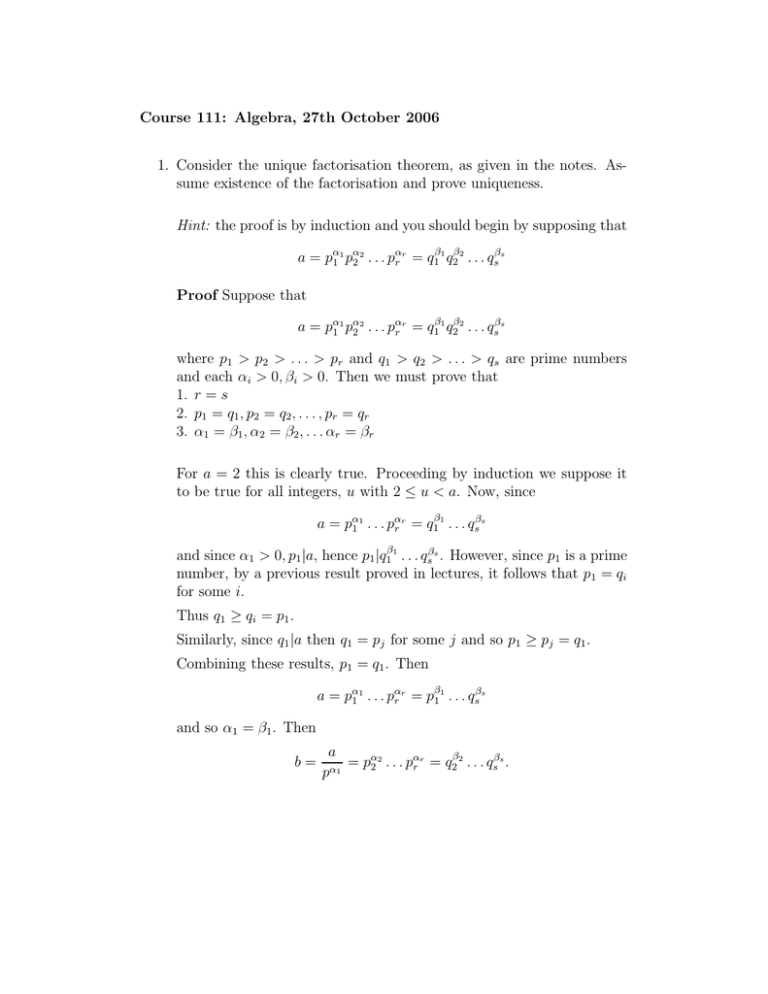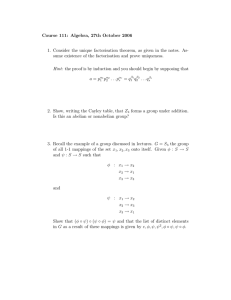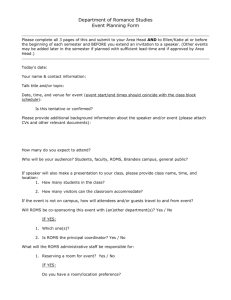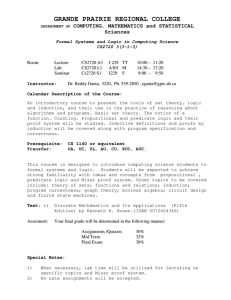Course 111: Algebra, 27th October 2006
advertisement

Course 111: Algebra, 27th October 2006 1. Consider the unique factorisation theorem, as given in the notes. Assume existence of the factorisation and prove uniqueness. Hint: the proof is by induction and you should begin by supposing that a = pα1 1 pα2 2 . . . pαr r = q1β1 q2β2 . . . qsβs Proof Suppose that a = pα1 1 pα2 2 . . . pαr r = q1β1 q2β2 . . . qsβs where p1 > p2 > . . . > pr and q1 > q2 > . . . > qs are prime numbers and each αi > 0, βi > 0. Then we must prove that 1. r = s 2. p1 = q1 , p2 = q2 , . . . , pr = qr 3. α1 = β1 , α2 = β2 , . . . αr = βr For a = 2 this is clearly true. Proceeding by induction we suppose it to be true for all integers, u with 2 ≤ u < a. Now, since a = pα1 1 . . . pαr r = q1β1 . . . qsβs and since α1 > 0, p1 |a, hence p1 |q1β1 . . . qsβs . However, since p1 is a prime number, by a previous result proved in lectures, it follows that p1 = qi for some i. Thus q1 ≥ qi = p1 . Similarly, since q1 |a then q1 = pj for some j and so p1 ≥ pj = q1 . Combining these results, p1 = q1 . Then a = pα1 1 . . . pαr r = pβ1 1 . . . qsβs and so α1 = β1 . Then b= a = pα2 2 . . . pαr r = q2β2 . . . qsβs . p α1 Now, if b = 1 say, then α2 = . . . = αr = 0 and β2 = . . . = βr = 0. And in this case r = s = 1 giving the result. Next, say b > 1 then since b < a you can use induction on b to deduce the following 1. the number of distinct (prime) power factors on both sides is the same so r − 1 = s − 1 ⇒ r = s. 2. α2 = β2 , . . . , αr = βr . 3. p2 = q2 , . . . pr = qr . Combined with the results: p1 = q1 and α1 = β1 the theorem is proven. Note: the assumption of the uniqueness of factorisation for integers < a implied the uniqueness of factorisation for a. And so induction completes the proof. 2. Show, writing the Cayley table, that Z4 forms a group under addition. Is this an abelian or nonabelian group? 0 1 2 3 0 0 1 2 3 1 1 2 3 0 2 2 3 0 1 3 3 0 1 2 Z4 is abelian. 3. Recall the example of a group discussed in lectures. G = S3 the group of all 1-1 mappings of the set x1 , x2 , x3 onto itself. Given φ : S → S and ψ : S → S such that φ : x1 → x 2 x2 → x 1 x3 → x 3 and ψ : x1 → x 2 x2 → x 3 x3 → x 1 Show that (φ ◦ ψ) ◦ (ψ ◦ φ) = ψ and that the list of distinct elements in G as a result of these mappings is given by e, φ, ψ, ψ 2 , φ ◦ ψ, ψ ◦ φ. (φ ◦ ψ) ◦ (ψ ◦ φ) = = = = = = = φ ◦ (ψ ◦ (ψ ◦ φ)) φ ◦ (ψ 2 ◦ φ) φ ◦ (ψ −1 ◦ φ) φ ◦ (φ ◦ ψ) φ2 ◦ ψ e◦ψ ψ








